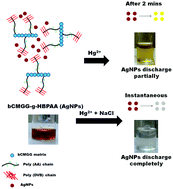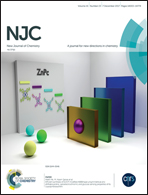Exploration of carboxymethyl guargum grafted hyperbranched poly(acrylic acid) as a scaffold for silver nanoparticles for ultrafast and selective sensing of Hg(ii)†
Abstract
Carboxymethyl guargum-g-poly(acrylic acid)-co-poly(divinyl benzene), bCMGG-g-HBPAA, having an unprecedented hyperbranched architecture is developed. A combination of a polymer grafting technique and “Strathclyde methodology” in emulsion is followed for the first time in the synthesis of bCMGG-g-HBPAA. FTIR, NMR, intrinsic viscosity and linear viscoelasticity studies confirm the microstructure of bCMGG-g-HBPAA. Owing to the unique properties of polysaccharide and hyperbranched chains, bCMGG-g-HBPAA successfully stabilizes monodispersed silver nanoparticles (AgNPs-HB) of size 27 nm and with good optical clarity. AgNPs-HB forms an amalgam in the presence of Hg2+ and thus facilitates colorimetric detection/accurate estimation of Hg2+ (up to 1 ppb). Furthermore, for the first time it is shown that the specificity and sensitivity of AgNPs-HB based sensors towards Hg2+ sensing can be enhanced in the presence of Na salt catalysts. The working principle of AgNPs-HB and AgNPs-HB/Na salt(s) based sensors for Hg2+ is explained through UV-Vis, XRD, HRTEM and CV studies.



 Please wait while we load your content...
Please wait while we load your content...